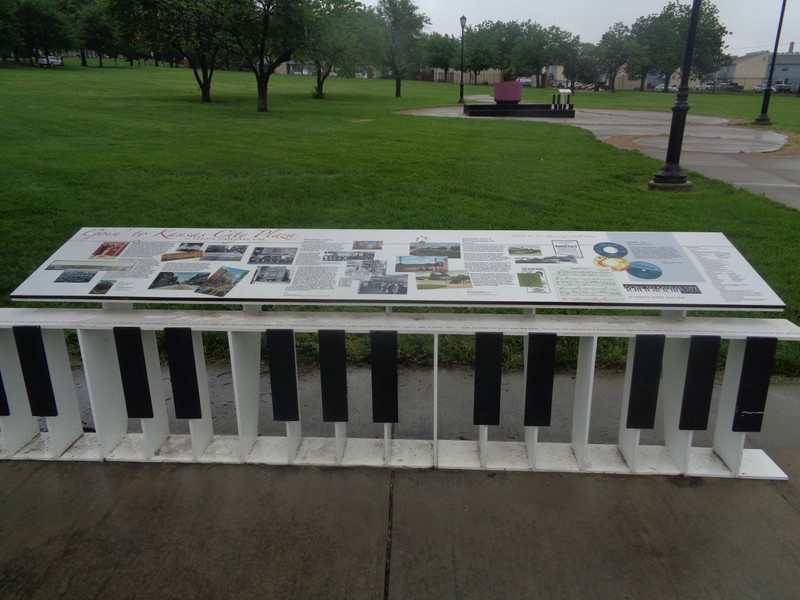Goin to Kansas City Plaza Historical Marker: 12th Street and Vine
Introduction
Text-to-speech Audio
This historical marker pays tribute to a former intersection within one of the most bustling communities in Kansas City in the early and mid-20th century that was immortalized by the 1959 hit "Kansas City" by Wilbert Harrison that was covered and adapted by musicians from Little Richards to the Beatles. The song references a prior era when this area hosted some of the leading jazz clubs, theaters, and dining spots in the city, a "wide Open" period of pre-Depression era Kansas City immortalized by ragtime composer Euday Bowman's 12th Street Rag in 1914." Bowman's song inspired numerous additional songs about Kansas City, including "Kansas City," written by Jerry Leiber and Mike Stoller in 1952 and made popular by Wilbert Harrison in 1959. The intersection was no longer the city's hot spot for music and entertainment by 1959, and it no longer exists following urban renewal programs of the 1970s that replaced this section of Vine Street with an urban green space. While 12th and Vine may be a memory, the history of the area is kept alive with this memorial space designed to resemble a piano and treble clef, a nod to the still-popular song that expresses excitement to be "going to Kansas City" for its women and wine and plans to "be standing on the corner of Twelfth Street and Vine."
Images
This marker is shaped like a piano with photos and the lyrical lyrics of the song "Kansas City"

Backstory and Context
Text-to-speech Audio
The 1950s Rhythm and Blues song “Kansas City” immortalized the intersection of 12th and Vine with the lyrics, “I'm gonna be standing on the corner, of Twelfth Street and Vine. With my Kansas City baby and a bottle of Kansas City wine.” Covered and adapted by musicians such as James Brown, Little Richard, and the Beatles, the 1959 hit "Kansas City" became the official theme song of the city in 2005. Near this marker, one can experience a taste of the city's jazz history by visiting the nearby 18th and Vine District, also known as the city's Jazz District. The area is home to historic buildings, museums, and working jazz clubs that pay homage to the unique "Kansas City Sound" that was pioneered by Big Joe Turner and others who authored numerous songs about the city that filled the gap between Euday Bowman's 12th Street Rag and Wilbert Harrison's hit song.
By the roaring twenties, what was once a forested area of the emerging city became one of the trendiest places to live and visit. It was a bustling thoroughfare lined with theaters, clubs, jazz, and of course, barbeque. The nearby Orchid Room was one of the premier Rhythm and Blues clubs hosting the likes of Etta James, Ray Charles, Fats Domino, and Ruth Brown in the 1940s and 1950s. Legendary jazz venues inspired the songs that captured the imagination of songwriters Jerry Leiber and Mike Stoller. Had the songwriting duo visited Kansas City in their time, they would have likely referenced the clubs around 18th and Vine, downtown venues along 12th Street, the Pla-More Ballroom on 31st Street, or clubs like Miltons and the Century Room on Troost between Linwood and Armour Boulevard.
By the time "Kansas City" became a hit for Wilbert Harrison, the heyday of 12th Street and Vine was a memory, and many residents of this neighborhood were moving further south. The neighborhood’s Roaring Twenties heyday faded as the leading theaters, clubs, and joints closed their doors. Even the famed Orchid Room, which outlasted most other clubs, filed for bankruptcy in 1959. What took their place in the late fifties and early sixties were venues such as burlesques and strip clubs. Some referred to the area as “the Las Vegas of its day,” owing to open and widespread prostitution and other activities that inspired the next generation of city leaders to demolish area structures and construct Paseo Green Park.
The Urban Renewal projects of the late fifties into the seventies were a widespread public planning effort to remove blighted areas from cities and expand infrastructure in their place. This program, while aiming to improve the city, had mixed results. While leading to the construction of more public housing, there were tremendously negative results for those left behind, including many for Black Kansas Citians. Homes and businesses around the historic intersection of 12th and Vine were bulldozed, but this green space and memorial plaza at the former intersection of 12th and Vine shares the history and culture of the area from Euday Bowman's 12th Street Rag to the numerous versions of "Kansas City" that followed.
Cite This Entry
Antolini, Jacob and Clio Admin. "Goin to Kansas City Plaza Historical Marker: 12th Street and Vine." Clio: Your Guide to History. June 8, 2024. Accessed March 20, 2025. https://theclio.com/entry/182313
Sources
Voigt, Jason. The Rebirth of Twelfth and Vine, Historical Marker Database. May 28th, 2022. Accessed June 2nd, 2024. https://www.hmdb.org/m.asp?m=198767.
Reeves, Matt. URBAN DEMOLITION LEADS TO PRESERVATION, KCHistory.org. August 17th, 2020. Accessed June 2nd, 2024. https://kchistory.org/blog/urban-demolition-leads-preservation.
Ferruzza, Charles. News Flash To The World: Kansas City Has No '12th Street And Vine' — Here's Why, KCUR.org. May 16th, 2016. Accessed June 2nd, 2024. https://www.kcur.org/arts-life/2016-05-16/news-flash-to-the-world-kansas-city-has-no-12th-street-and-vine-heres-why.
Hogan, Suzanne. The History Behind The Paseo, One Of Kansas City's First Boulevards, KCUR.org. May 23rd, 2017. Accessed June 2nd, 2024. https://www.kcur.org/community/2017-05-23/the-history-behind-the-paseo-one-of-kansas-citys-first-boulevards.
Lyles, Wes. JAZZ MUSICIANS OUTSIDE THE ORCHID ROOM AT 12TH AND VINE, KCHistory.org. Accessed June 2nd, 2024. https://kchistory.org/image/jazz-musicians-outside-orchid-room-12th-and-vine.
Walk, Devin. 12th Street: Kansas City’s Jazz Age hotspot, Memories of The Prairie. July 11th, 2023. Accessed June 2nd, 2024. https://memoriesoftheprairie.com/blog-1/2023/07/11/12th-street-kansas-city-jazz-age/.
Photo by Jason Voigt https://www.hmdb.org/PhotoFullSize.asp?PhotoID=662547

